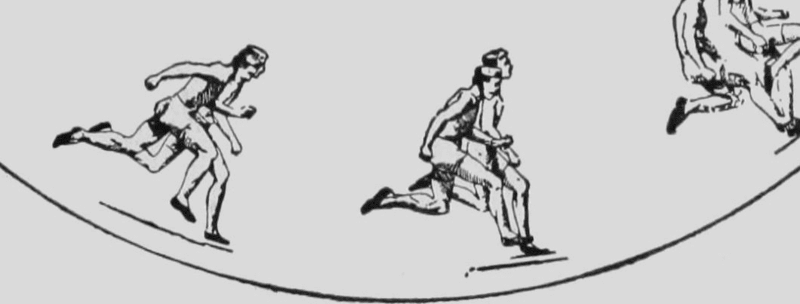An attempt to run the fastest ever backward marathon highlights how wrong-way locomotion could assist in rehabilitation and athletic training.
Original post – Friday, April 13, 2018 – 11:15 – Peter Gwynne, Contributor (Inside Science). Published on Runner’s Tribe with permission.

(Inside Science) — The Boston Marathon is not only the world’s oldest annual marathon; it’s one of the toughest.
Runners must negotiate a series of hills that become particularly difficult at mile 20 with the notorious Heartbreak Hill, just when their reserves of energy and willpower are faltering.
Imagine trying to run the Boston course backward.
That’s what 33-year-old Los Angeles lawyer Loren Zitomersky plans to do on Monday.
His reason: charity.
He wants to promote awareness of — and funding to support research and patient care for — epilepsy, a condition that killed a half-brother whom Zitomersky never knew. He publicizes his goal through a website, https://bostonbackwards.com.
Over the past 20 years, Zitomersky and his father have raised more than $300,000 for epilepsy-connected causes in road races, triathlons, and cycling events. The Boston Marathon represents an opportunity to promote the work on a grand scale and raise up to $100,000.
After qualifying for Boston in his seventh (and fastest) forward-running marathon at the Mountains 2 Beach marathon in Ventura, California, last May, “I decided to do something really big,” Zitomersky said. “I stumbled upon the world record for running backwards and decided to do it.”
Markus Jürgens of Germany set the current record at 3 hours, 38 minutes and 27 seconds in the Hannover marathon last April. That’s less than 8 minutes and 20 seconds per mile. The Guinness World Records currently recognizes Xu Zhenjun’s time of 3 hours 43 minutes and 39 seconds in the 2004 Beijing marathon as the top backward running performance. It’s this time that Zitomersky is trying to best.
Beating either runner’s time won’t be easy.
“It’s a tough record, so he’ll have his hands full,” said Brian Godsey, an American data scientist who holds the world record for running 5 kilometers backward.
Zitomersky reached that conclusion last June, when he started backward running. “I realized how difficult it was after about half a mile,” he recalled. “I wondered if I could do it.”
Exacerbating the problem was the lack of solid information about the equipment, safety and technique for running backward. “No one was able to give me good answers,” he said.
He persisted, however, and since mid-December has logged about 535 backward-running miles. That includes the last 20 and a half miles of last month’s Los Angeles marathon, which he had started running forward.
Zitomersky has paid a price for the training.
Running backward requires about 30 percent more energy than forward locomotion. “It’s taken a toll on my body,” he said. Running backward “is a lot tougher on certain muscles. It’s tough on my feet, my calves, my quads and my glutes.” Regular massages also revealed a very sore neck.
“But it’s not only tough on the muscles; it’s tough on the mind,” he added. “You have to stay as aware as possible. You have to make sure that you don’t run into a tree or fall into a ditch.”
In Boston, a friend will run with Zitomersky as a spotter to warn him of obstacles ahead. And four other runners will provide an escort to prevent him bumping into other runners by accident.
Beyond drawing attention to the Epilepsy Foundation, the recipient of donations to his website, Zitomersky’s effort focuses attention on potential benefits of small-scale backward running.
A few studies have suggested that brief bouts of walking backward can support rehabilitation following certain muscle injuries, particularly to the knees. It can also improve the balance of individuals with conditions such as Parkinson’s disease. And some trainers include a few minutes of backward running on a treadmill as part of a regime for conventional road and track runners. It may even help people recover from some medical conditions.
“Backwards running has traditionally been used in rehabilitation for disorders such as stroke and lower leg extremity injuries,” said Jason Ordway, director of track and field and cross country at the University of Dayton.
A study in 2011 by researchers at the University of Milan in Italy provided support for that approach. The team found that, whereas forward running involves a “soft takeoff” when muscle-tendon units shorten and a “hard landing” when they stretch, backward running involves a hard takeoff and soft landing. Although backward running uses energy less efficiently, the team concludes, it puts less pressure on the knees.
Five-kilometer record holder Godsey has benefited from that effect. “I have experienced improvement in my knee condition” after training to run backward, he said.
Some coaches have started to use the approach to train elite forward runners. A research project by Ordway and colleagues in 2016 found that the use of energy by eight highly trained male runners improved after five weeks of backward running training on a treadmill.
So however Zitomersky fares in Boston, his retro effort will expose the running world to his grit and the charitable reason that stimulated it.
Editor’s note: This story was edited after publication to note that Zitomersky is aiming to beat the current Guinness World Record, not the more recently set world record as described in the original story.